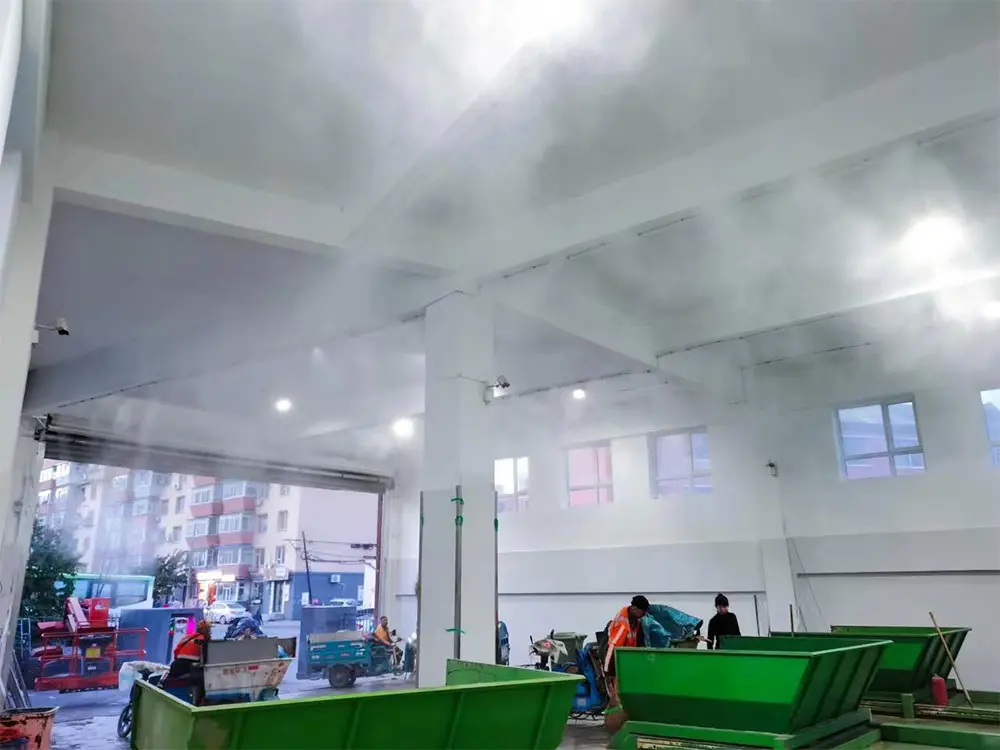As a concentrated area of urban garbage, garbage stations are prone to generating pungent odors and breeding bacteria,
viruses and other pathogens. This not only seriously affects the surrounding environment and the quality of life of residents,
but also poses a threat to public health. Traditional deodorization and disinfection methods have many drawbacks,
such as strong irritation of chemical agents and slow effect of microbial deodorants. Against this backdrop, hypochlorous acid generators,
with their unique advantages, have become the ideal choice for deodorization and disinfection in garbage stations

The application methods of hypochlorous acid in garbage stations
1,1 Hypochlorous acid is used for surface spraying of garbage
Use the spray equipment to evenly spray the hypochlorous acid solution on the surface of the garbage.
For kitchen waste and other high-water-content, easily perishable and odor-producing waste,
appropriately increasing the concentration of hypochlorous acid to 300-500 PPM can effectively inhibit the growth and reproduction of microorganisms in the waste,
reducing the generation of malodorous gases such as ammonia and hydrogen sulfide from the source. Take a large-scale kitchen waste treatment station as an example
. Every day, hypochlorous acid solution is sprayed on the garbage at regular intervals. After spraying,
the number of microorganisms on the surface of the garbage is significantly reduced, and the ammonia concentration drops from the initial 80ppm to below 20ppm.
1,2 Hypochlorous acid is used for spatial atomization deodorization in garbage dumps
With the aid of high-pressure atomization equipment, hypochlorous acid solution is atomized into tiny particles (with diameters ranging from 1 to 10 microns)
and diffused throughout the entire space of the garbage station. These micron-sized hypochlorous acid particles have an extremely large specific surface area
and can quickly come into contact with malodorous molecules in the air and undergo oxidation reactions, covering every corner of the garbage station,
including hard-to-clean dead corners. If a certain community garbage station adopts the spatial atomization deodorization method,
and the atomization equipment is turned on at regular intervals for 15 to 20 minutes every day, the hydrogen sulfide concentration inside the
garbage station will drop from the original 30ppm to below 5ppm, and the spatial odor will be significantly reduce.
1,3 The treatment of leachate in garbage by hypochlorous acid
Leachate from garbage is complex in composition, containing a large amount of organic matter, ammonia nitrogen and other pollutants.
It emits a strong odor and pollutes the environment. When hypochlorous acid solution is add to the leachate treatment system,
the strong oxidizing property of hypochlorous acid can decompose the organic pollutants in the leachate, reduce its chemical oxygen demand (COD),
and at the same time kill the pathogenic microorganisms in it, reducing the generation of odor. After the leachate treatment station of
a certain landfill site was treat with hypochlorous acid, the COD removal rate of the leachate reach 30% – 40%,
the effluent quality was significantly improve, and the odor in the surrounding area was greatly reduce

The deodorizing advantages of hypochlorous acid
2,1 Hypochlorous acid has highly efficient deodorization and disinfection effects
Hypochlorous acid has strong oxidizing properties and can rapidly oxidize and decompose malodorous molecules
such as hydrogen sulfide, ammonia, and methyl mercaptan produced in garbage, achieving an extremely high deodorization efficiency.
Experiments show that hypochlorous acid can reduce the concentration of hydrogen sulfide from 50 PPM to below 5ppm within 30 minutes,
and the ammonia removal rate exceeds 90%. Meanwhile, it has a broad-spectrum killing effect on pathogens such as bacteria,
viruses and fungi, with an inactivation rate exceeding 99%. For instance, it can effectively kill common bacteria in garbage such as Escherichia coli,
Staphylococcus aureus and influenza virus, fundamentally blocking the generation of odors and the transmission routes of diseases.
2,2 Hypochlorous acid is safe and environmentally friendly when deodorizing
After its action, it naturally degrades into water and a trace amount of salt. It has no pungent smell, does not irritate human skin or respiratory tract,
and will not cause secondary pollution. Compared with traditional chlorine-containing disinfectants, hypochlorous acid has extremely low corrosiveness,
causes less damage to metal equipment and buildings in garbage stations, and can extend the service life of equipment and facilities.
In a densely populated garbage station environment, using hypochlorous acid generators for deodorization and disinfection can ensure the health and safety of the staff and the surrounding residents.
2,3 The concentration of the hypochlorous acid generator is adjustable, suitable for various scenarios in the garbage station
The equipment is easy to operate and can flexibly adjust the generation volume and usage concentration of hypochlorous acid solution according to
the scale of the garbage station, the type of garbage and the degree of odor. It is applicable to both large-scale garbage transfer stations and
small community garbage rooms. In the event of a sudden increase in the amount of garbage or a sudden stench, the usage of
hypochlorous acid can also be rapidly increase to promptly control the odor and keep the environment clean.

Customer feedback shows that the effect is remarkable
At a large garbage transfer station in Shanghai, before the hypochlorous acid generator is put into use, the ammonia concentration remain at around 100ppm for a long time,
and complaints from the surrounding residents kept coming. After the introduction of the hypochlorous acid generator, through measures
such as spraying on the surface of the garbage and spatial atomization deodorization, the ammonia concentration rapidly dropped below 10ppm,
and the number of complaints from the surrounding residents decreased by 80%. In a garbage room of a certain community in Shenzhen,
hypochlorous acid solution is spray twice a day at regular intervals. The intensity of the odor has been reduce by 90%,
and the breeding situation of mosquitoes and flies has been significantly improve, creating a cleaner and more comfortable living environment for the residents.
FAQ
1,How does hypochlorous acid achieve deodorization of garbage?
Hypochlorous acid (HClO) has strong oxidizing properties and can rapidly undergo oxidation-reduction reactions with odor-causing molecules such as ammonia and hydrogen sulfide in garbage,
decomposing these unstable and pungent substances into odorless small-molecule compounds, such as nitrogen, water and sulfate. Meanwhile,
hypochlorous acid can also destroy the cell walls and protein structures of bacteria, fungi and other microorganisms,
inhibit their growth and reproduction, and reduce the odor substances produced by microbial metabolism from the root, achieving the deodorization effect.
2,How long can the effect of hypochlorous acid in deodorizing garbage last
The duration of the deodorizing effect of hypochlorous acid is greatly influence by environmental factors.
In a well-ventilated and moderately humid environment, its effective action time is usually 2 to 4 hours.
If the garbage is piled up closely, the humidity is high and the ventilation is poor, the decomposition rate of hypochlorous acid will increase,
and the deodorization time may be shorten to 1-2 hours. Regular re-spraying of hypochlorous acid solution can maintain a good deodorization effect.
3,Is it safe to use hypochlorous acid for garbage deodorization?
Low-concentration hypochlorous acid (usually with an effective chlorine content of 50-200 PPM) is relatively safe for human health and the environment. After decomposition,
its main products are water and trace amounts of salts, with no residual harmful substances. However, high-concentration hypochlorous acid is corrosive.
Direct contact with the skin and eyes can cause irritation. When using it, protective gloves and goggles should be worn, and it should be keep away from children and pets.
It is recommend to use professionally proportioned hypochlorous acid deodorizing products to ensure safety.
